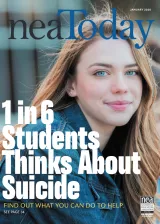In fall 2019, a video of a tragedy averted went viral. I’m sure many of you saw it, too, and felt as moved as I did. A student experiencing a mental health crisis walked into Parkrose High School, in Portland, Ore., wielding a gun. A nearby security guard looked into that student’s eyes and did not see a criminal.
Instead, he saw the student’s pain. The guard quickly grabbed the gun and—instead of pinning the student to the ground—he pulled the student into an embrace. After struggling to pull away, the student melted into the guard’s arms. No one in that school died that day.
The guard was very lucky. Trying to single-handedly disarm a student might not always work out so well. But this incident is such a beautiful metaphor for how educators can respond when a student is going through a mental health crisis.
The student may lash out or try to pull away. But what that student needs most is to feel a connection. And educators are in a position to offer that life-saving remedy. This is more important now than ever.
Our schools and our nation are facing a mental health epidemic among young people. Suicide is the second leading cause of death among people ages 15 to 24. And one in six young people have reported “seriously considering suicide.”
Let’s allow that to sink in. That means in every class of 30 students, there may be five young people who are living with suicidal thoughts. These numbers are even higher among high school girls, with 22 percent of those surveyed saying they have seriously considered suicide.
And among gay, lesbian, and bisexual high school students, that number skyrockets to about 48 percent. And suicide is even increasing among middle school students. In the face of these odds, it’s easy for educators to feel powerless.
We know all too well the pressures on school counselors and psychologists.
Due to severe funding cuts, one counselor is often responsible for 500 students, and school psychologists are often responsible for twice that number. But one on one, we can still make a difference.
Suicide is preventable. In this issue, we share the stories of educators who have fought through their own grief to become champions of suicide prevention training.
We talk with others who have learned how to spot the warning signs and have the hard conversations. We answer the question: When is it OK to ask, “Are you thinking about suicide?”
Students need to know that educators are trusted adults they can turn to in times of crisis. And, when students are brave enough to ask for help, educators must know how to respond.
This is real. This is personal. I lost my husband to suicide. Like so many others, his lifelong battle with depression started in high school. This is why educators must be prepared to offer their hand.
I applaud educators who take suicide-prevention training, so they can help support their students. We can have an impact—one conversation at a time.


